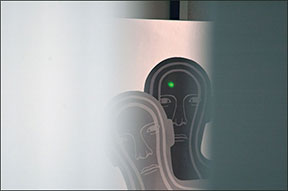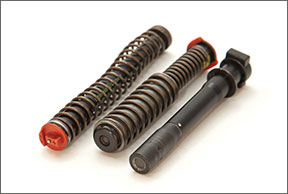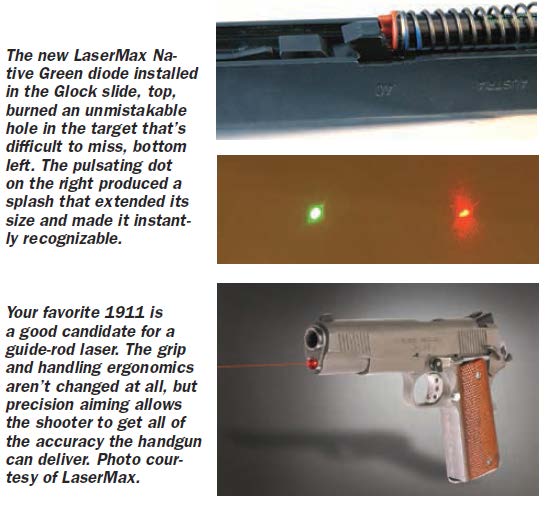Stance, grip, trigger control, and sight alignment are widely recognized as fundamentals necessary for accurate shooting. But what about when firing from a cramped position, where the shooter is not able to extend his arms and put the sights between the shooter’s eye and the target? One answer is to rely on a laser unit to project the desired point of impact. Other advantages to laser aiming would be maintaining full vision of the field of threat and not having to rely on one’s near vision to define an adequate sight picture.

288
Despite these advantages, one of the reasons why laser aiming units are not more popular may be cost, both in terms of the unit itself and perhaps a new holster to accommodate the added bulk. Not to mention that your gun must be equipped with an accessory rail. One maker of laser aiming devices offers several models to address each of these concerns. LaserMax, based in Rochester, New York first came to our attention by offering a laser projection unit integrated with the guide rod. This goes back to the days before accessory rails were a common feature. The LaserMax guide-rod units replace the guide rod and the slide stop (or slide release, depending on the pistol) with a fitting that adds a crossbolt-style on/off switch that is ambidextrous.
This means the shooter can turn on the crossbolt switch with either a one- or a two-handed grip. First, the index finger (from its off-trigger position) can slide the switch toward the bore and activate the light. The thumb typically rides along the opposite side of the frame and can be used to turn the laser off. Or, the switch can be activated with the support-hand thumb and turned off by the trigger finger when the action has ceased. We prefer the first method because the operator could be tempted to leave the index finger inside the trigger guard in anticipation of a shot that may prove unnecessary.
Some makers of laser aiming devices have chosen to integrate the on/off switch within the grip itself to make activation somewhat automatic. Problem: In some cases, it’s too easy to concentrate more on keeping the laser activated than maintaining an effective shooting grip. Instead, the LaserMax system makes ignition a separate, distinct function. The maker refers to this as “Controlled Activation.” LaserMax’s reasoning is, “to be the person who controls the life-threatening situation, you must be able to activate your laser only when you’re ready to fire.” We see this as an extension of one of the sacred rules of firearms safety, “Keep your finger outside the trigger guard until ready to shoot.” An added benefit of controlled activation is to limit the possibility of giving away the operator’s position.
To find out more, we shopped Brownells.com so we could test LaserMax units designed to be attached to the exterior of the pistol via the accessory rail. The rail-mount units were the $130 Uni-Max Micro Rail Mounted Laser LMS-Micro (Brownells #100-006-164WB) and the $370 Uni-Max Rail Mount Laser Sight LMS-UNI-G (Brownells #100-003-568WB).
At CheaperThanDirt.com, we found the guide-rod units, in which the laser components replace the existing guide rod and recoil spring. They were the $358 LMS-2291 for Sig Sauer P229 (CTD # 8-LM-LMS2291), a $302 LMS-1191 for a Glock 30SF (CTD # 9-43085), and a new $400 LMS-1141G Native Green unit for a Glock 22 (CTD # 8-LM-LMS1141G).
In addition, there was a replacement slide stop or slide latch depending on the individual gun that supplied the on/off switch. We wondered if the combination of laser projection with the recoil assembly would affect reliability. We also wanted to know how reliable the units were, both in terms of illumination and how well they would hold their points of aim. Would they prove cumbersome to activate and get in the way? Would we really be able to see the dots? Let’s find out.
LaserMax Micro and UNI-G Rail Mount Laser Units
Both units were Weaver and Picatinny compatible. The rail units were held in place by a single crossing bolt with a slot-head screw on the right-hand side. It wasn’t necessary to turn the bolt to maximum pressure, but when removing the unit and then replacing it, we had to make sure and apply the same amount of tension to the mounting bolt. We found that our settings within the unit remained secure, but as we turned the bolt, we were effectively changing windage adjustment as well. As we tightened the bolt, we could see the beam travel from right to left. The key was to settle on how much torque is needed the first time you apply the unit and zero the beam. Thereafter, you can use the mounting bolt as a quasi-windage adjustment screw and again steer the beam into place behind the front sight as you tighten the bolt. We couldn’t account for any real variation due to wear in this process, but in our view it is certainly conceivable that windage adjustment after remounting could become necessary.

288
But these units were not designed for quick-on and quick-off application. We think the intention of this design was for the unit to remain with the gun at all times.
Whereas the guide-rod lasers were zeroed at the factory for 20 yards, the rail-mount units can be zeroed for any distance. But 20 yards is probably a good rule of thumb to account for the trajectory of most handgun rounds.
However, if the unit is mounted on a defensive handgun that is expected be used exclusively inside the home, there is no reason why the laser cannot be zeroed for precisely the furthest distance from which one might need to shoot. For example, the distance from the bedroom door to the front entrance.
The LMS-Micro was the smaller of the two rail-mounted units. Weighing in at 0.5 ounces including the 3-volt 1/3N battery, we didn’t notice it was on the gun. External dimensions were less than 1.25 inches front to back, about 1.1 inches side to side, and about 0.6 inches tall. LaserMax rail units feature FRN construction (fiberglass reinforced nylon), but the battery cover was a thin steel plate.
We turned the LMS-Micro on and off by pressing inward on either the left- or right-hand-side paddles. Unlike the other units, the Micro’s switch did not shift laterally. It was actually more of an on/off button. To make adjustments for windage and elevation, we inserted the supplied Allen wrench into the small reliefs located on the bottom and left side of the unit. In both cases, we could zero the laser’s point of aim to the sights (co-witness) without firing the gun. With the gun steadied and with a clear sight picture, we could steer the beam by turning the windage adjustment until the dot sat just above the front sight. Then, we turned the elevation screw until it all but disappeared behind the front sight blade.
The LMS-Micro produced a piercing red dot. Battery life was rated at 5 hours with a 10-minute auto-shutoff feature, which was unique to this unit. Whereas the constant dot was easy to pick up, we preferred the option of using its pulsating beam. To switch between constant and pulse modes, we pressed both switches inward with the beam on for about 5 to 8 seconds. In our experience, the pulse mode is advantageous because the human eye is drawn quickly to movement as well as to points of bright light.
The LMS-UNI-G differs from the Micro by being larger and operating with a true crossbolt switch that physically moves to the on position to the left or right. It keeps a low profile beneath the dustcover, about a half-inch in depth. A nice touch: the LMS-UNI-G offers a Picatinny rail so that a light unit can be attached to the bottom of the unit. While some other units offer both a light and a laser, we liked the option of removing the light for daytime shooting and decreasing overall bulk.
The LMS-UNI-G projected a full-time pulsating green laser beam. Our colorblind tester reported that he saw the green laser as a pure white light — imagine a tactical flashlight beam that’s very concentrated and intense. But he never had trouble finding the laser dot even when it was immersed in the beam of a high-power flashlight. Battery supply was two 3-volt 1/3N batteries beneath a FRN cover held by two Phillips-head screws. An optional momentary on/off switch is also available, so the LMS-UNI-G could also be applied to other types of firearms as well. This unit was adjustable for windage and elevation, tool supplied.
Because the UNI-G utilized a crossbolt operating switch that physically shifted left and right, we wondered if it could accidentally be turned on. We tested switch integrity by mounting the UNI-G on a Springfield Armory XDM 3.8 40 S&W and using it as our house, car, and shop gun. In the house it sat in a night stand drawer on top of and around several odds and ends, including knives, spare magazines, keys, etc. In the car, it was in and out of the glove box. In the shop, we managed to knock it off the bench a couple of times and shove it roughly in and out of hiding places. We learned that it took a conscious effort to bump the switch against something to turn it on. Otherwise the paddles, were protected, recessed within the contours of the trigger guard, dustcover and the unit itself.

500
Our Team Said: Neither the LMS-Micro nor the UNI-G were designed to be part-time quickly-attachable aiming devices. Instead, these are highly efficient tools that can be easily integrated into one’s training and routines. Complete ambidextrous operation made them highly effective, whether the gun was held in one or both hands. In our view, nothing beats the pulsing dot — especially after the first shot, where recoil has disturbed point of aim and elements such as smoke can complicate visual recovery. Overall, we’d choose the LMS-Micro in pulse mode for a carry gun. In the house we’d prefer the UNI-G for its extra accessory rail and its flamethrower dot brightness.
LaserMax Guide-Rod Laser Units
To test the LaserMax guide-rod systems, we tried installation in three different pistols: the Glock 30SF 45 ACP, a Sig Sauer P229 with 40 S&W and 357 Sig barrels; and a 40 S&W Glock 22 Gen 3. The Glock 22 unit was the latest generation of LaserMax technology called Native Green. Introduced in August 2013, the first green Guide Rod models offered were compatible with Glock models 17, 17L, 17 Gen4, 18, 19, 19 Gen4, 20, 20SF, 21, 21SF, 22, 22 Gen4, 23, 24, 31, 32, 34, 35, 37 and 38. We think there was enough variation in this trio to find out if the LaserMax guide rod system was truly reliable.
In stock condition, the compact G30SF works from a two-stage plunger and spring recoil system. The Glock 22 used a single captured spring over a polymer guide rod. The Glock guide-rod units converted the slide lock into a switch by supplying a substitute spring and a slide lock that was relieved to allow it to move left and right. In each case when the slide lock was off center the laser beam was illuminated. We thought pushing the edges of the Glock slide lock was more comfortable and easier to use than the peg found on the Sig Sauer unit.
The P229 used a solid guide rod with a flat wound spring captured at the front by the slide yoke. Included in the kit for the Sig Sauer pistol was a complete replacement slide stop latch with on/off switch in the shape of a peg centered inside a dished relief to help the shooter find it with either the support-hand thumb or the tip of the index (trigger) finger.
It’s worth noting the Sig Sauer P229, which was tested in the August 2001 issue, had been upgraded to the latest grip design and refreshed at the factory, so it was not a true “stock” gun. Nonetheless, reliability remained 100% after installing the LaserMax guide rod unit, and we found the gun was noticeably easier to shoot.
All three of the guide rod units displayed a pulsating beam. The Sig Sauer and Glock 30SF units sent a red/orange beam. The LaserMax guide rod fit to our Glock 22 Gen 3 pistol fired a green laser. Now available for all generations of the G22 and other models, including the new Gen 4 pistols, this was LaserMax’s newest edition, the Native Green. LaserMax developed the Native Green laser diode for greater efficiency at both low and high operating temperatures. With fewer parts, the unit is lighter and generates less heat while producing a brighter dot.
Point of aim was predetermined at the factory for a 20-yard zero, with the source of the laser beam indexed by proper installation. This was virtually goof proof because, if it is not installed properly, the top end of the pistol will not fit the frame. The only real mistake you can make is installing the guide rod upside down. But predetermined zero is based on factory specs. If the barrel has been ported or the gun otherwise modified, the gun may need to be sent to LaserMax for custom fitting to achieve the proper zero.
The orange fitting at the end of the unit that contacts the barrel lug slides off to expose the battery chamber. LaserMax makes a battery pack for each model, but replacement batteries such as Energizer 319 or Energizer 393 batteries can be installed. LaserMax suggested changing the power supply annually with normal use. Each pistol and laser unit withstood a minimum of 350 rounds without any problems whatsoever. Each of the units, save the one mounted in the Glock 22, was kept in service for seven months. After this time, only the guide-rod unit mounted in the G30SF showed noticeable reduction in illumination and required battery replacement.
Our Team Said: We liked the guide-rod-mounted lasers because we could continue using our current holsters and older model guns that do not have an accessory rail. And there are more choices when shopping for a new holster. The switches were secure and distance to the operating switch was the same no matter what the barrel length. Battery life was more than adequate, and the supplied illumination was brilliant. The strength of the recoil springs are well matched to the weapons, we found. In fact, cycling and control from the Sig Sauer unit was better than when using the stock recoil spring and guide rod, especially when shooting with the 357 Sig barrel.
Looking at the units head to head, we think the LaserMax green laser in pulse mode is the most effective combination for emergency tactical fire. And once Native Green technology is available for your pistol, we strongly recommend it.
Written and photographed by Roger Eckstine, using evaluations from Gun Tests team testers. GT




























